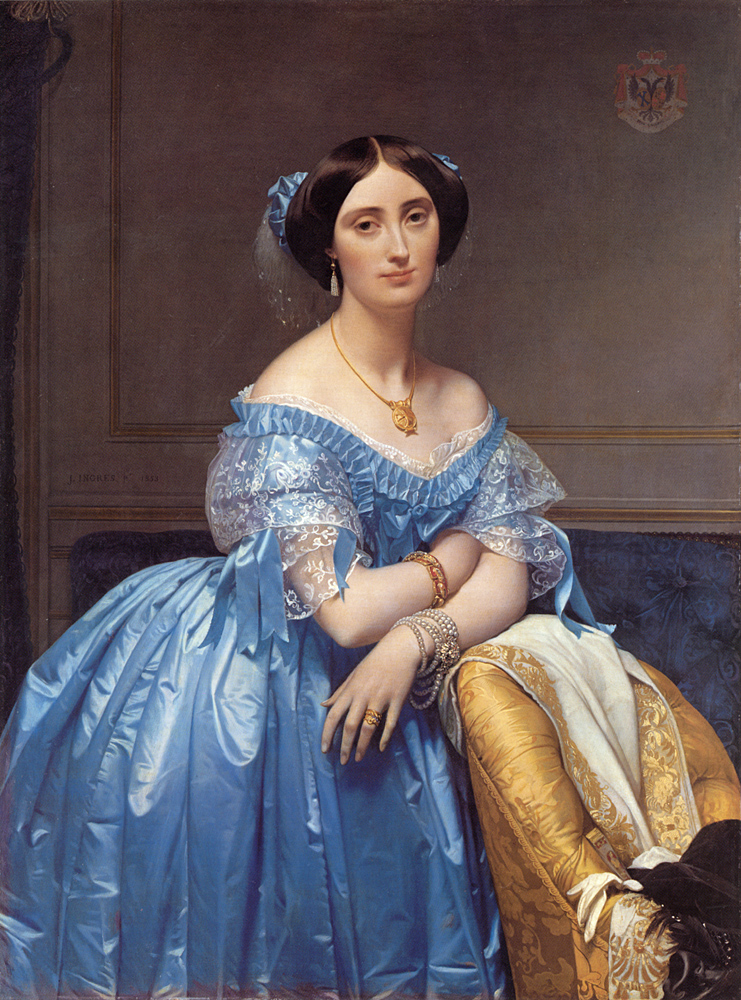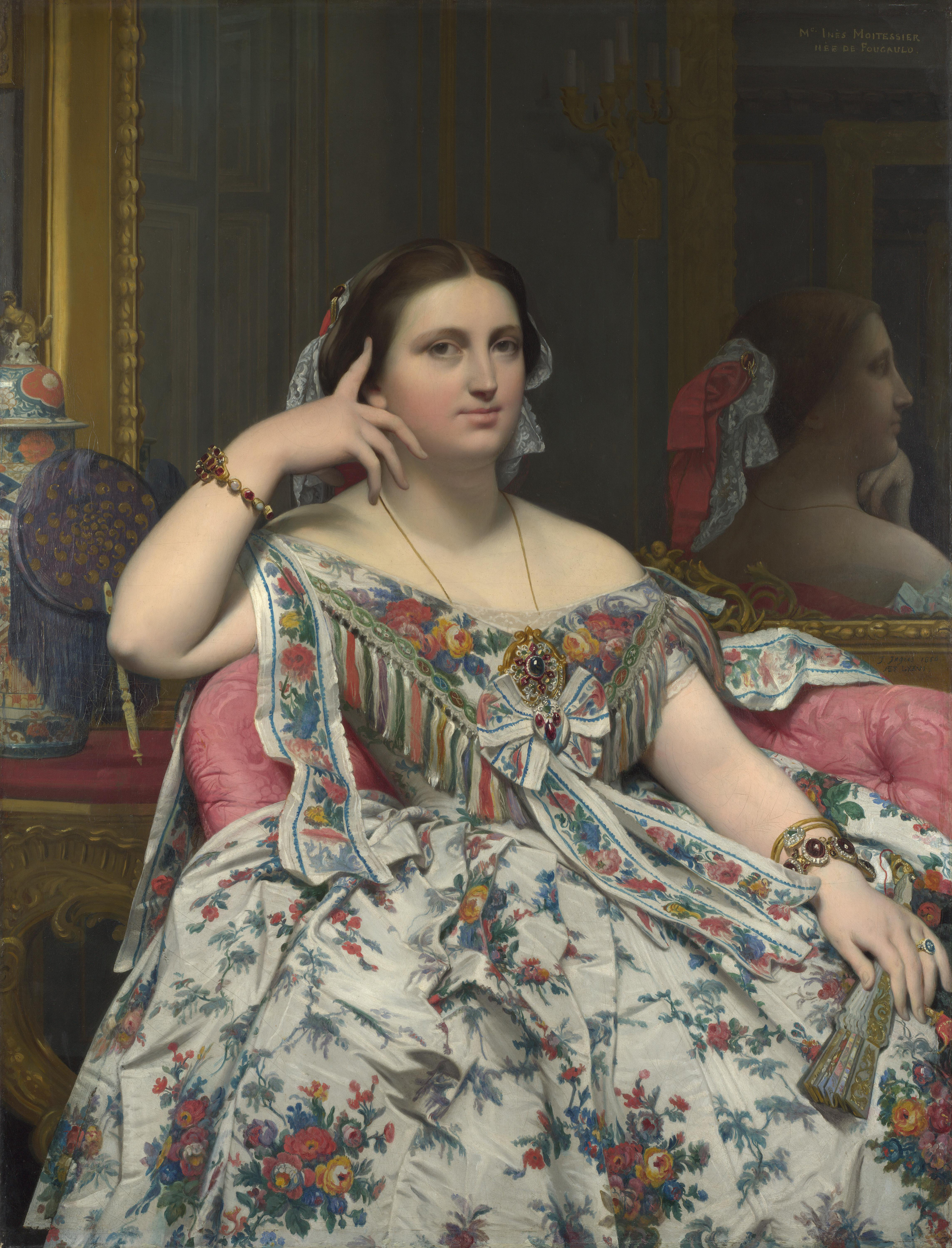The Immortal Line: Jean-Auguste-Dominique Ingres and the Art of Portraiture in Contrast with His Contemporaries
 |
| Princess Albert de Broglie : Jean Auguste Dominique Ingres Oil on canvas Size121.2 × 90.7 cm Metropolitan Museum of Art Manhattan, New York, USA |
Ingres remains an artist of unshakable stature, standing at the precipice where Neoclassicism met Romanticism, and where precision met passion.
Though the march of art history has carried many of his contemporaries into the realms of innovation and modern abstraction, Ingres stands firmly rooted in the soil of classical idealism. His devotion to line, form, and aesthetic order elevated his portraits into almost architectural marvels. Yet, far from being cold constructions, his works hum with a hidden sensuality, a contained passion that peeks from under the veil of discipline.
To study Ingres is to enter a world of control and clarity, of idealized humanity filtered through the sieve of draftsmanship. And perhaps no portrait more beautifully manifests this than his painting of Princesse de Broglie (1851–1853), a work that, though tender and elegant, echoes the artist’s relentless pursuit of formal perfection.
The Geometry of Grace: Princesse de Broglie
 |
| Princess Albert de Broglie : Jean Auguste Dominique Ingres Metropolitan Museum of Art Manhattan, New York, USA |
Born in 1825, Pauline de Broglie was twenty-eight years old when she sat for Ingres. Her beauty was well-documented, but so too was her reticence; deeply religious and painfully shy, she was not a woman one would expect to see immortalized in such sumptuous elegance.
Yet, in Princesse de Broglie, Ingres managed to capture not only her beauty but her delicate composure, her inwardness, her solitude—cloaked as it is in opulence.
Her gaze, though poised and still, speaks of an internal distance. Her posture is that of an apparition held together by grace and duty.
Ingres was, by this time, well into his artistic maturity, having painted many prominent figures of the royal court and French bourgeoisie. But this portrait posed unique challenges.
He was hesitant to accept the commission, partly due to his increasing preference for historical subjects.
 |
| Madame Moitessier Oil on Canvas Jean Auguste Dominique Ingres National Gallery, Central London |
The painting is remarkable not only for its rendering of the subject but for how it transforms textiles into nearly sculptural forms.
The elaborate dress, composed of a lustrous blue satin trimmed with lace, is painted with such finesse that it seems nearly tangible.
The cool texture of the silk reflects a naturalistic light that, paradoxically, adds to the idealism of the composition. Her gloved hand rests on a gilded armrest. Pearls and jewels dot her neckline, yet none overpower the demure intelligence that emanates from her face.
In the mirror behind her, her reflection stares at us from another angle—an extraordinary feat of both technique and symbolism. This duality in the painting suggests more than a mere physical likeness; it offers the viewer two visions of the sitter: the composed external self and the reflected, perhaps more contemplative, interior self. It is a masterstroke of psychological layering.
The subdued background, cast in soft earth tones, pushes the cool blue and alabaster skin tones of the sitter forward, emphasizing the depth and luminosity of the central figure. This chiaroscuro, subtle yet deliberate, is evidence of Ingres’s careful control of light and shadow, not to evoke drama—as in Caravaggio or Delacroix—but to sculpt serenity.
Drawing as Virtue: Ingres’s Artistic Philosophy
 |
Jean-Auguste-Dominique Ingres, Public domain, via Wikimedia Commons Virgin of the Adoption |
For him, drawing was not a means to an end, but the soul of art itself. “Drawing,” he declared, “is the probity of art.”
In this he saw virtue in delineation, in form, in clarity. This belief distinguished him from contemporaries such as Eugène Delacroix, who leaned more toward expressive color and energetic brushwork.
Ingres’s portraits, even when rendered in oil, feel as if they were first carved in graphite. The sculptural precision of the human form, the geometric elegance of posture, and the controlled cascades of fabric all attest to the supremacy of line.
In the portrait of Princesse de Broglie, this is evident not only in the curves of her face and arms but in the sinuous folds of her dress and the precise geometry of her seated form.
He was trained in the strict academic tradition, and his early admiration for Raphael stayed with him throughout his life. Yet, unlike Raphael, whose figures float with divine lightness, Ingres’s figures are rooted in the weight of earthly beauty—elevated not by divine symbolism, but by their structural harmony. He once said, “The harmony of the line is what I seek, not the truth of the color.” This statement casts light on his entire oeuvre.
Ingres’s compositional strength also lay in his ability to simplify without impoverishing. Faces, necklines, and hands are painted with an economical grace that avoids overstatement. He did not chase fleeting impressions. He was not interested in transitory effects of light or momentary gestures, but in the permanence of a moment captured in equilibrium.
Ingres and Renoir: Aesthetic Dissonance and Shared Sensuality
 |
Pierre-Auguste Renoir, |
Where Ingres leaned into line and idealization, Renoir embraced color and atmosphere. Where Ingres’s women are poised in statuesque calm, Renoir’s women are caught in the movement of laughter, dance, or intimate reflection.
Yet, paradoxically, both painters shared an intense admiration for the human form—particularly the female form. Renoir, in his later years, became obsessed with classical beauty.
He abandoned the fleeting sun-dappled techniques of early Impressionism and returned to something more solid, more Ingres-like. His nudes, though painted with Impressionist brushstrokes, bear a volumetric sensuality reminiscent of antique sculpture. There is an unspoken dialogue between Renoir’s late bathers and Ingres’s cool muses. In both, the body is not merely represented; it is revered.
In one striking example, Renoir’s Gabrielle with a Rose (1911) shows a young woman seated in profile, rendered in soft pastel tones. Though the colors are fluid and the brushstrokes tender, the structure of the pose—graceful neck, turned head, half-seated composition—echoes the formal strategies of Ingres. The difference lies in surface: Renoir lets color dissolve the contours, whereas Ingres seals the surface with firm outline.
 |
Pierre-Auguste Renoir, |
In Portrait of Madame Charpentier (1878), Renoir’s sitter lounges in rich textiles, but these never dominate her presence; instead, they merge with her being. By contrast, Princesse de Broglie almost seems embedded within her dress, subsumed by her social elegance and reticence.
Memory in Marble: Ingres's Place Among the Immortals
Ingres was born in 1780 and died in 1867, living through the rise and fall of empires, the tumult of revolutions, and the reshaping of the French cultural landscape. His career spanned decades of profound transformation in art and society. Yet, unlike Delacroix or Courbet, he did not reinvent his style to suit new epochs. His commitment to classical order and line remained unwavering, and perhaps therein lies his greatest strength and limitation.
Ingres’s drawings alone number in the thousands, many done as commissions for tourists or aspiring patrons. These pencil sketches, seemingly modest, reveal his mastery of the human figure. One can see in them the foundational structure upon which his oil portraits were built. His renowned La Grande Odalisque (1814), though erotic in subject, maintains the same linear devotion—a body elongated beyond anatomical realism, not due to error, but in service of elegance.
His portraits are architectural in the way cathedrals are—each element designed to support the whole. While contemporaries may have experimented with perspective, realism, or color theory, Ingres returned again and again to his own cathedral of form.
The Enduring Silence of Ingres
 |
Jean-Auguste-Dominique Ingres, Public domain, via Wikimedia Commons Madame Ingres, née Madeleine Chapelle Foundation E.G. Bührle Collection |
Today, in the 21st century, Ingres may appear an anachronism. His work is too controlled for modern expressionism, too idealized for contemporary realism. And yet, his influence remains profound.
He is not simply a historical figure; he is a silent companion to every artist who values line over spontaneity, structure over spectacle.
His legacy lingers not in revolution but in refinement. The portrait of Princesse de Broglie does not shout—it whispers. It does not dazzle—it endures.
In a world increasingly intoxicated by novelty, the classical serenity of Ingres provides a necessary balance, a reminder that beauty, order, and restraint still possess their own kind of daring.
Ingres’s art remains a testament to the belief that every painted portrait is, at its core, a self-portrait of the artist's own ideals. It is this inward illumination that makes his work more than mere representation—it is revelation.